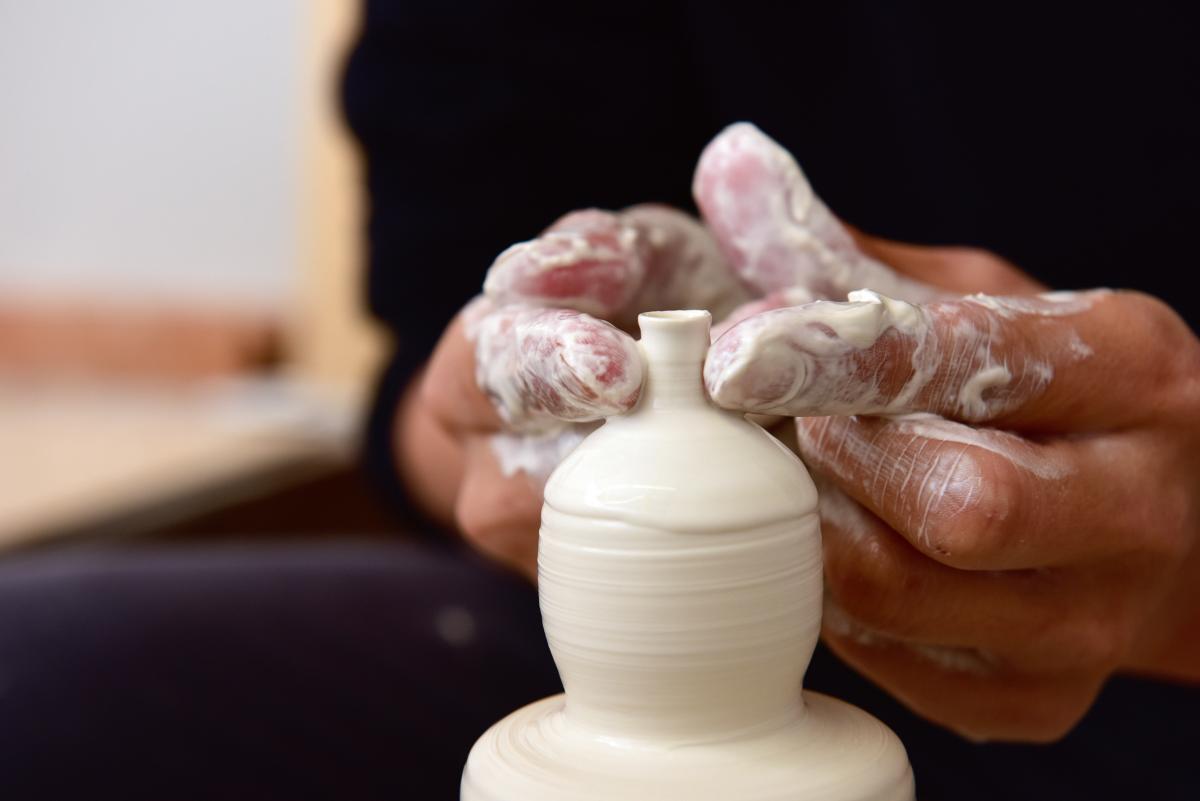This wonderful Cornish workshop and museum is dedicated to the legacy of studio pottery trailblazer Bernard Leach
Ones to watch in the world of ceramics
Ones to watch in the world of ceramics
3 May 2018
In our spring issue, our Editor-in-Chief, Sue Herdman, explored how the medium of contemporary ceramics has reached its current boundary-breaking practice.
Here she spotlights the work of five ceramic artists whose reputations are on the rise.
Matt Davis
Matt Davis’s ceramic practice is, he says, ‘about challenging our preconceptions on the relationship between technology and traditional craft’. Combining digital technology with the handmade, he creates exciting pieces – from tiles to vessels – that he describes as ‘hyperreal’. Favouring the starkness of black or white, his works are made in a 3D printed mould and finished in bone china or porcelain. They are crisp and tactile, urging the viewer to explore them by touch.
Davis’s practice is growing in ambition and at this spring’s Ceramic Art London he showed three new works – his Li-ion vessels, Wedesus urn and Twist vessels. Last year, at the same show, he was the recipient of the Emmanuel Cooper Award, which saw three of his pieces go to The Potteries Museum & Art Gallery at Stoke-on-Trent. Heal’s, meanwhile, chose him as one of four emerging designers to promote in its Heal’s Discovers collection. It’ll be fascinating to see what he does next. ceramicsx.co.uk
Hannah Tounsend
I first spotted Hannah Tounsend’s arresting work in 2015 at the British Ceramics Biennial in Stoke-on-Trent, where she was the winner of the FRESH award. A graduate from De Montfort University, where she gained a BA in Ceramics and Glass and an MA in Fine Art, Tounsend creates elegantly layered hand-thrown and slip-cast pieces. To these she adds beautiful surface decoration using a subtle palette, both of which draw on the coastal landscapes of Sussex, Cornwall and more.
Tounsend’s latest achievement, a few weeks ago, was winning the Best Newcomer to Ceramic Art London [CAL] Award (CAL being one of the highlights of the international ceramic events annually). Her stand featured not just her ceramic pieces – which are growing each year in size – but her abstract prints and watercolours too, which echo the decoration of her clay work. Placed together they make a powerful display. hannahtounsend.co.uk
Matthew Warner
If you caught Matthew Warner’s solo show earlier this year at Contemporary Applied Arts, you’ll have seen why his work is fast gaining the eye of collectors and critics. A graduate of Camberwell College of Arts’ ceramics course, Warner is both studio potter and artist. He has worked as an apprentice to one of the UK’s leading potters, Julian Stair, and since winning the Cockpit Arts/Clear Award in 2015, has had his own studio at Cockpit Arts in Deptford.
Warner’s early practice has been noted for his fine, fluid, pared-down porcelain tableware. Recently, however, his approach has developed to focus on melding past and present. He’s interested in historical European ceramics and, in his new body of work, has been referencing the pieces of the 18th-century British potter Josiah Wedgwood. The results are sleek and classical, but with a contemporary edge. They are less about function and more about form. If you’re new to collecting ceramics, Warner’s pieces could be a very good place to start. matthewwarner.co.uk
Sophie Southgate
Sophie Southgate is a ceramic artist whose fine works bring a shot of sunshine to any space they inhabit. She studied at Cardiff Metropolitan University and, on graduating, was awarded a scholarship to study on the clay course at Penland School of Crafts in North Carolina. She then went on to Fireworks Clay Studios on a graduate residency. Now her practice is truly gaining momentum. A bold colourist, her pieces are, she says, inspired by elements such as shifting weather patterns, geometry and big landscapes.
Working with slip-cast earthenware and porcelain vitreous slips, she admits that her work ‘doesn’t neatly fit in to the “art” or the “design” box’. Instead, she likes to retain a gentle ambiguity about her sculptures. They certainly have the ability to tease the eye, luring the viewer in with their vibrant optical illusions. sophiesouthgate.com
Yuta Segawa
The first time I saw Yuta Segawa’s work was a couple of years ago at Ceramics in the City at London’s Geffrye Museum. There was a huge buzz around his stand. When I got through the throng, I could see why. Segawa makes exquisitely perfect vessels using more than 500 original glazes. The real difference with his practice, though, is that, so far, he has chosen to work in miniature. There is something about this Lilliputian size that holds great appeal. It has also attracted younger collectors, who find it affordable to purchase one, two, three or more pieces, as the size makes his entry point prices realisable.
A graduate of Musashino Art University in Tokyo and Camberwell College of Arts, Segawa is fascinated with the relationship between scale and art. He studied the experimental Japanese art of the Gutai movement (1954 to around 1972), which focused on the relationship between the human body and material. Now, as he concentrates on tiny vessels, he is testing the limits of what a human can make on such a small scale. yutasegawa.com

For our feature on ceramics, see the spring issue of The Arts Society Magazine, which is free to Members and Supporters of the Society.
Images: Yuta Segawa
About the Author
Sue Herdman
JOIN OUR MAILING LIST
Become an instant expert!
Find out more about the arts by becoming a Supporter of The Arts Society.
For just £20 a year you will receive invitations to exclusive member events and courses, special offers and concessions, our regular newsletter and our beautiful arts magazine, full of news, views, events and artist profiles.
FIND YOUR NEAREST SOCIETY
MORE FEATURES
Ever wanted to write a crime novel? As Britain’s annual crime writing festival opens, we uncover some top leads
It’s just 10 days until the Summer Olympic Games open in Paris. To mark the moment, Simon Inglis reveals how art and design play a key part in this, the world’s most spectacular multi-sport competition



